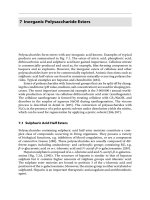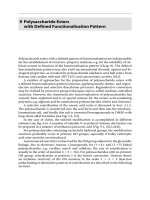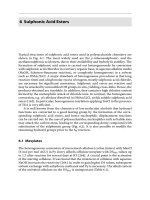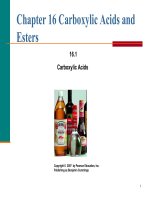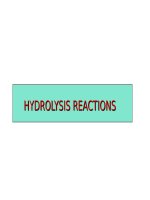INORGANIC POLYSACCHARIDE ESTERS
Bạn đang xem bản rút gọn của tài liệu. Xem và tải ngay bản đầy đủ của tài liệu tại đây (380.75 KB, 13 trang )
7 Inorganic Polysaccharide Esters
Polysaccharides form esters with any inorganic acid known. Examples of typical
products are summarised in Fig. 7.1. The esters of nitric acid, phosphoric acid,
dithiocarbonic acid and sulphuric acid have gained importance. Cellulose nitrate
is commercially produced and used as, for example, film-forming component in
lacquers and as explosive. However, the inorganic esters of cellulose and other
polysaccharides have yet to be commercially exploited. Anionic functions such as
sulphuric acid half esters are found in numerous naturally occurring polysaccha-
rides. Typical examples are heparan and chondroitin [284].
Esters of polysaccharides with functional groups that can be split off by chang-
ing theconditions (pHvalue, medium,saltconcentration) areused for shapingpro-
cesses. The most important commercial example is the 3 000 000 t annual world-
wide production of rayon via cellulose dithiocarbonic acid ester (xanthogenate).
The cellulose xanthogenate is formed by treating cellulose with CS
2
/NaOH, and
dissolves in the surplus of aqueous NaOH during xanthogenation. The viscose
process is described in detail in [285]. The conversion of polysaccharides with
N
2
O
4
in the presence of a polar aprotic solvent under dissolution yields the nitrite,
which can be used for regeneration by applying a protic solvent [286, 287].
7.1 Sulphuric Acid Half Esters
Polysaccharides containing sulphuric acid half ester moieties constitute a com-
plex class of compounds occurring in living organisms. They possess a variety
of biological functions, e.g. inhibition of blood coagulation, or are a component
of connective tissues [288]. These polysaccharides are usually composed of dif-
ferent sugars including aminodeoxy- and carboxylic groups containing RU, e.g.
β
-d-glucuronic acid or
α
-l-iduronic acid and N-acetyl-
β
-d-galactosamine [289].
Heparansulphateiscomposedof
α
-l-iduronic acid and N-acetyl-
β
-d-galactos-
amine (Fig. 7.2A, [290]). The structure of heparin is similar to that of heparan
sulphate but it contains higher amounts of sulphate groups and iduronic acid.
Thesulphateestermoietiesareboundtoposition3ofthel-iduronic acid and
position6 of the d-galactosamine. Moreover, the amino group is either acetylatedor
sulphated. Heparin is an important therapeutic anticoagulant and antithrombotic
agent.
130 7 Inorganic Polysaccharide Esters
Fig. 7.1. Examples of polysaccharide esters of inorganic acids
The main sugar moieties of chondroitin, a component of cartilage and connec-
tive tissue, are
β
-d-glucuronic acid and N-acetyl-
β
-d-galactosamine connected
via
β
-(1→3) linkages [291]. Sulphuric acid half esters are found at position 4 or
6oftheN-acetyl-
β
-d-galactosamine (see Fig. 7.2B for chondroitin-6-sulphate).
Dermatan sulphate consists of l-iduronic acid, rather than d-glucuronic acid
(Fig. 7.2C) [292].
Sulphuric acid half ester moieties are introduced in polysaccharides in order to
render water-insoluble biopolymers soluble and to impart biological activity. For
instance, curdlan, which is not very water soluble, gives clear solutions after intro-
duction of a small amount of sulphuric acid half ester groups, as little as 4.4 mol%
(DS 0.04) [293]. Consequently, sulphation of polysaccharides is an important path
for structure- and property design.
Several homogeneous and heterogeneous synthesis paths have been developed
for the preparation of artificially sulphated polysaccharides. The ester, in its H
+
form, is strongly acidic, which causes autocatalytic hydrolysis of the ester moieties
and also chain degradation. Therefore, it is converted to the salt form, often the
sodium salt, which is water soluble and stable in aqueous systems.
In general, sulphation can be accomplished using various reagents such as
ClSO
3
H, SO
3
and H
2
SO
4
. Treating polysaccharides with concentrated or slightly
diluted H
2
SO
4
may lead to sulphation. Under these conditions, a remarkable
7.1 Sulphuric Acid Half Esters 131
Fig. 7.2. Typical repeating units of
heparan sulphate (A), chondroitin-6-
sulphate (B), and dermatan sulphate
(C)
depolymerisation occurs. H
2
SO
4
can also be applied in combination with low-
molecular alcohols because alkyl sulphates are formed and act as reactive species.
In addition, the polymer degradation is comparably low. Chlorosulphonic acid
and sulphur trioxide are powerful sulphating agents, although a major drawback
of these reagents is the sensitivity to moisture. A convenient method to reduce
the risk during the synthesis is the application of the complexes of ClSO
3
Hand
SO
3
with organic bases (e.g. TEA, Py) or aprotic dipolar solvents (e.g. DMF),
which are commercially available. SO
3
-DMF and SO
3
-Py are white solids that are
easy to use. These efficient and easily manageable reagents produce well-defined
polysaccharide sulphuric acid half esters, which may exhibit bioactivity. Curdlan-
and sulphuric acid half esters are in the centre of interest as cancerostatics and
anti-HIV agents.
DMF is a typical reaction medium for the sulphation of polysaccharides, e.g.
amylose and amylopectin, which dissolves or at least swells the polymer. It can
also be applied with comparable efficiency for guaran, as shown in Fig. 7.3 [294].
A convenient method for the synthesis of curdlan sulphuric acid half ester is
dissolution of the polymer in aprotic dipolar media, treatment with SO
3
-Py, and
subsequent neutralisation to the sodium salt. The sulphation of curdlan swollen
in formamide with SO
3
-Py complex yields products with DS as high as 2.10 within
4 h at RT (Table 7.1, [295]).
Curdlan sulphuric acid half esters with DS 1.6 are obtainable using piperidine-
N-sulphonic acid in DMSO solution. Sulphation with SO
3
-Py complex in Py slurry
yields products with DS up to 2.6, while almost complete functionalisation can be
132 7 Inorganic Polysaccharide Esters
Fig. 7.3. Sulphation of polysaccharides in
DMF with SO
3
-TMAfor24hat0°C(adapted
from [294])
Table 7.1. Sulphation of curdlan with SO
3
-Py in formamide for 24 h at RT (adapted from [295])
Molar ratio Product
AGU SO
3
-Py Partial DS
S(%) DS O-6 O-4 O-2
1 2.0 10.4 0.93 n.d. n.d. n.d.
1 2.5 13.6 1.45 1.00 0.14 0.31
1 3.0 14.6 1.75 1.00 0.31 0.44
1 4.0 15.6 1.98 1.00 0.50 0.48
1 5.0 16.1 2.10 n.d. n.d. n.d.
achieved with ClSO
3
H in Py. The latter two products possess negative specific rota-
tions, leading to the conclusion that the original helical structure of curdlan might
be retained. According to
13
C NMR measurements, the piperidine-N-sulphonic
acid is highly O-6 selective, while OH groups at position 6 still remain in the
products prepared with SO
3
-Py and ClSO
3
H (Table 7.2, [296]).
Table 7.2. Sulphation of curdlan with different reagents for 60 min at 85 °C
Reaction conditions Curdlan sulphate
Sulphating reagent Molar ratio Temp. (°C) DS [
α
]
25
D
(°)
AGU Reagent
Piperidine-N-sulphonic acid 1 4.0 85 1.60 −1.5
SO
3
-pyridine complex 1 15.2 85 2.40 −14.9
ClSO
3
H 1 6.3 100 2.60 −16.0
ClSO
3
H 1 12.6 100 2.90 −22.0
7.1 Sulphuric Acid Half Esters 133
Conversion of curdlan dissolved in DMSO/LiCl with SO
3
-Py for 4 h at 80
◦
C
yields sulphuric acid half esters with DS 1.7 [177]. Highly derivatised polysaccha-
ride sulphuric acid half esters can be prepared using a large excess of the reagent
in DMF for 6 h at 40
◦
C. For instance, a DS of 2.8–2.9 can be realised for curdlan,
galactan, amylose and cellulose. DS 2.1 is achieved for xylan, which contains not
only xylose RU but also some glucuronic acid moieties [297].
A heterogeneous procedure for the sulphation of (1→3)-
β
-d-glucans isolated
from Saccharomyces cerevisae with a H
2
SO
4
/isopropanol mixture yields the sul-
phuric acid half ester [298]. After the reaction, the product is filtered off and
separated from unreacted starting polymer by dissolution in water. The yield
(37%) is low, compared to homogeneous conversions.
Sodium alginate sulphuric acidhalf ester isobtainablebythe reaction of sodium
alginate with a mixture of ClSO
3
H and formamide. The product obtained after 4 h
at 60
◦
C possesses a DS of 1.41 [299]. Sodium alginate sulphuric acid half ester
shows a considerably high anticoagulant activity, which can be further increased
by subsequent quaternisation with 2,3-epoxypropyltrimethylammonium chloride.
Starchsulphuricacidhalfestershavebeenpreparedbyusingvariousreagents
(Table 7.3). Highly sulphated products with DS as high as 2.9 are obtainable with
ClSO
3
H, SO
3
,SO
3
-Py, SO
3
-DMSO in aprotic media. Interestingly, sulphation can
be achieved also in aqueous reaction media applying different reagents derived
from SO
3
or ClSO
3
H. Sulphation to low DS values is carried out in order to improve
the dissolution behaviour of starch.
Table 7.3. Reagents for the sulphation of starch
Reagent Medium DS Ref.
H
2
SO
4
Diethylether 0.25 [300]
ClSO
3
H Formamide
SO
3
/formamide < 1.8 [301–304]
Sodium nitrite/sodium bisulphite Dry < 0.02 [305]
Urea/sulphamic acid Dry < 0.04 [306]
SO
3
/tertiary amine Water/organic solvent [307, 308]
SO
3
/Py DMF 2.9 [297]
SO
3
/DMSO DMSO 2.4 [309]
SO
3
/DMF DMF 1.6 [310, 311]
SO
3
/TMA H
2
O < 0.1 [312]
N-Methylimidazole-N
-sulphonate H
2
O < 0.01 [313]
Many procedures have been developed for the preparation of cellulose sul-
phuric acid half esters. Simple dissolution of cellulose in 70–75% aqueous H
2
SO
4
yields a sulphated but highly degraded derivative. Heterogeneous synthesis, using
amixtureofH
2
SO
4
and low-molecular alcohols, e.g. n-propanol, leads to cellulose


